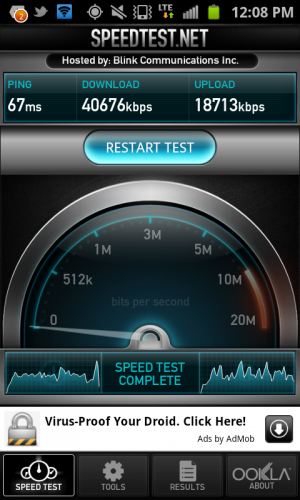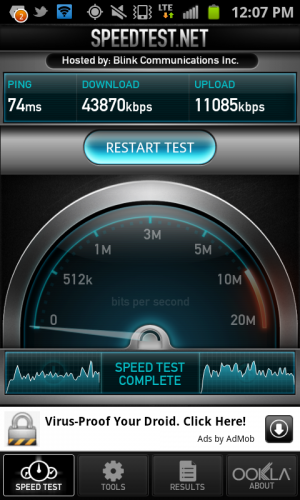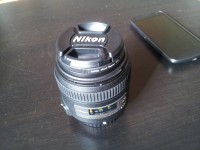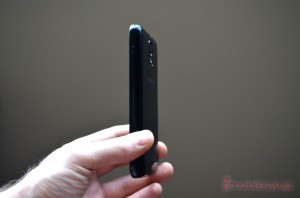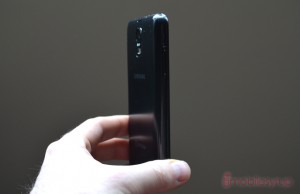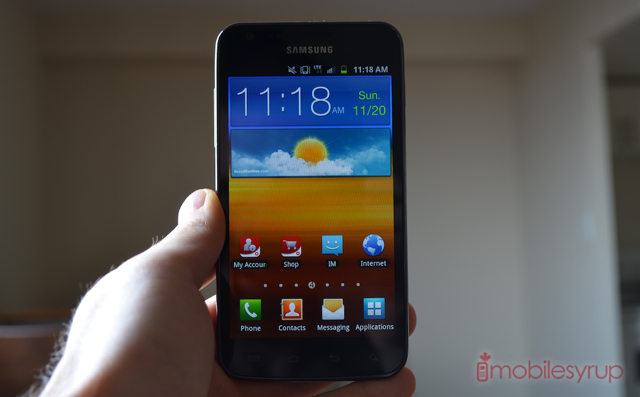
Amidst the chaos and confusion of the Galaxy Nexus debut — which carriers? when is it coming? — Rogers has quietly released its own iteration of the venerable Galaxy S II from Samsung. The major differentiator here is the addition of an LTE chip inside and a more spacious battery to keep everything chugging along.
And while the exterior is going to be instantly recognizable to Android familiars, there is a lot of nice stuff under the hood, so let’s take a look.
Specs:
– Android 2.3.5 Gingerbread with TouchWIZ4 overlay
– 4.5″ 800×480 pixel Super AMOLED Plus display
– 1.5Ghz APQ8060 Snapdragon S3 processor w/ Adreno 220 GPU
– 1GB RAM / 16GB internal storage (plus microSD slot)
– 8MP camera with LED flash / 2MP front camera
– 1080p video capture @ 30fps
– WiFi (b/g/n), Bluetooth 3.0, A-GPS, NFC, MHL(HDMI) output
– MDM9200 baseband LTE 75Mbps (700/1700/2100MHz), HSPA+ 21Mbps (850/900/1900/2100MHz) and quad-band GSM/EDGE (850/900/1800/1900MHz)
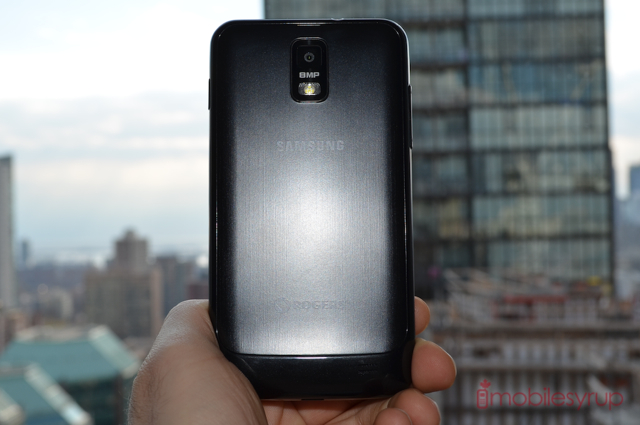
The Phone
Samsung sticks with familiar themes here: a thin, dark-hued body, all plastic. At 9.34mm it comes to about average for a device this size, and is certainly one of the thinnest LTE devices on the market. It is well-constructed, not brittle like the original Galaxy S, with a smooth battery door cover that is thicker and more rigid than its Bell or Telus counterparts. It is also metallic-looking, with a smooth graphite texture that exudes business professional.
Taking a tour around the device, we have a volume rocker on the left which seems sturdy and well-placed. On the right is the requisite Samsung power button; on the bottom a microUSB port and microphone; on top a 3.5mm headphone jack. The back houses the 8MP camera with LED flash, Samsung and Rogers logos and a small chin with an excellent mono speaker (more on that later). Thankfully the chin is less pronounced than previous Galaxy devices which lends a more symmetrical feel to the proceedings; there is something to be said for predictable, uniform handling.
The front of the device is taken up by the enormous 4.5″ Super AMOLED Plus display. Despite the relatively low resolution it is still technologically superior to almost any other touchscreen on the market. Black levels are perfect as AMOLED pixels are their own light source, negating the need for a backlight. Colour reproduction is highly saturated, almost excessively so, but there is a vividness and clarity to each pixel unmatched by even the higher-density HD display of the Galaxy Nexus. Because the Plus variant uses a true RGB palette, colours are truer and text sharper than an equivalent PenTile-based display.
That being said, after using the Galaxy Nexus at 720×1280 pixels on a 4.65″ screen, a screen of this size at 480×800 depicts icons and text in a comically oversized fashion. Icons appear enormous, and lines of text take up twice as much space. Though the LTE’s screen is probably the best of its kind, as we move on to larger, more pixel-dense varieties it is also likely the last of its kind. We cannot wait to see what Samsung’s next-generation Super AMOLED HD Plus delivers, but most people are going to be quite happy with the screen on this device.
Performance
If you’ve read our Telus Galaxy S II X review you pretty well know how the LTE version of the phone performs. The 1.5Ghz dual-core processor is still one of the computationally fastest on the market, hampered somewhat by an aging graphics processor that is overshadowed by Samsung’s own Exynos chip.
Because TouchWIZ4 is significantly more lightweight than HTC’s Sense overlay, or any other manufacturers’ for that matter, these Galaxy S II devices have a huge speed advantage with the same internal hardware; the LTE flies through its tasks with the confidence of a seasoned performer. The browser especially benefits greatly from Samsung’s software enhancements, scoring a fantastic 3060ms on the Sunspider JavaScript benchmark.
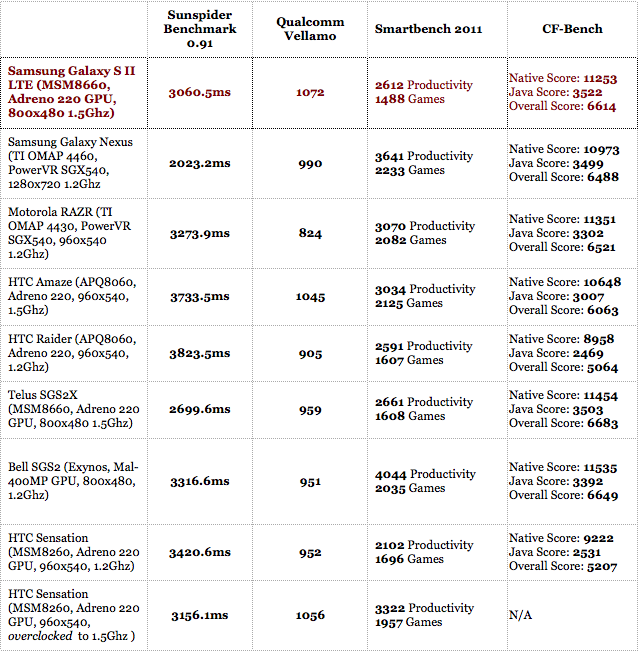
Though the LTE scores consistently lower in real-world and synthetic benchmarks than both the Bell SGS2 and the Telus SGS2X, the results are in the 2-5% margin of error. Its victory in the Vellamo benchmark is owed to its superior LTE connectivity than any CPU or GPU improvements. In real-world scenarios such as opening apps, scrolling through web pages there is no ostensible difference between the three devices, though the Bell version with its Exynos chipset feels ever so slightly smoother when playing graphic-intensive games such as Wind-up Knight.
We were extremely satisfied with the performance of the SGS2LTE; with its hyper-fast LTE connection, as you’ll see later, it feels much faster than a regular HSPA+ device. Web browsing and file downloads take on a whole new meaning, as one gets used to waiting mere seconds for files hundreds of megabytes to finish downloading. Of course, this takes its toll on battery life, but it’s a worthy compromise.
Connectivity and Network Speed
As we’ve mentioned, the Samsung Galaxy S II LTE has a Qualcomm-powered baseband inside, allowing up to 75Mbps download speeds in optimal conditions. This is the same MDM9200 chip that we found in the HTC Raider, and it’s very interesting comparing Rogers’ LTE speeds to Bell’s. For the most part they come in pretty close — both can push 30Mbps in optimal conditions — but we found Rogers to have better top speeds in most scenarios. We even hit a ridiculously high 44Mbps/11Mbps on one of our tests, and could reproduce at least 30Mbps almost every time. Upload speeds also seemed better on Rogers, as the LTE hit 19Mbps in one of our tests.
Of course, these speeds are unsustainable as more people connect to the carriers’ respective nascent LTE networks. Right now overall load is low, but in a couple years when all smartphones have transitioned over to LTE it may be a very different story. Rogers expects between 7-12Mbps down and 5-8Mbps up under regular circumstances with ping times below 80ms. To date, high latency has been the real speed killer with current HSPA+ networks; while speeds can exceed 10Mbps in real-world scenarios, ping times are often over 200ms, and sometimes as high as 1s. Regardless of how fast data can be transferred, if a connection between two nodes takes a long time it will significantly affect the feeling of speed. LTE aims to cut down that latency by up to 4x.
We also used the built-in WiFi hotspot feature built into Android to power our laptop on the go. Since we were hitting speeds of 40Mbps+ our internet connection felt significantly faster than most home broadband connections. And because our upload speeds were not capped like they are with cable or DSL we were able to upload a 50MB video file to YouTube in less than a minute. If mobile carriers can keep bandwidth costs low enough we see a number of users giving up their home broadband for LTE data sticks or WiFi hubs. Unfortunately at the moment the cost of LTE data is prohibitively expensive — $50/month for 10GB — and is not enough to supplant the hundreds of gigabytes often used by families at home.
If you are not in an LTE area, the device falls back to Rogers’ 21MBps HSPA+ network which, as we’ve learned, works exceptionally well in most circumstances. While we had less stunning results — 3-4Mbps down, 0.5-2Mbps up, 150-300ms pings — for the large swaths of Canada that does not yet have LTE (it is currently only available in Toronto, Ottawa, Montreal and Vancouver) but it’s nice to have that 4G network to fall back to.
Under regular conditions, using the excellent Samsung browser with Rogers’ incredible network speeds delivered by far the best mobile web experience we’ve had to date.
Battery Life
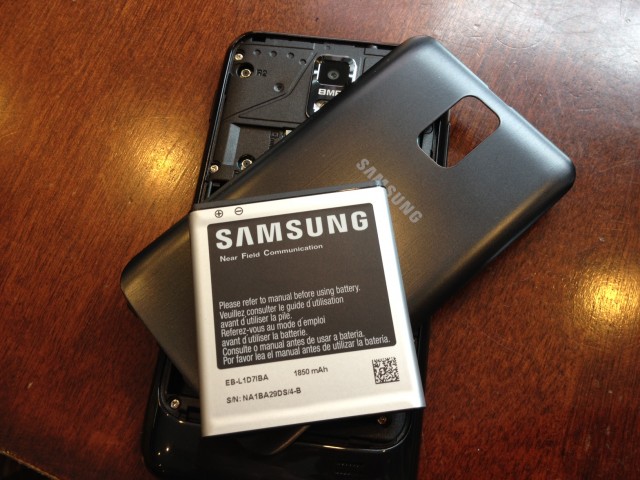
We had a great experience with the SGS2LTE. Battery life holds up quite well despite the LTE chip; we were able to get at least eight hours of regular use from the device, and over a day when using it sparingly. The problem with the current generation of LTE devices is that those fast speeds rely on a separate chip. All current HSPA+ devices have a baseband built into the SoC, which houses the CPU and GPU, substantially cutting down on battery expenditure.
Qualcomm has already announced the MSM8960 which has 2G/3G/LTE built into the SoC. This successor to this device’s MSM8660 should deliver significantly better battery life as a result of efficiency improvements to the CPU in addition to a low-power LTE baseband. Until then, no LTE device regardless of manufacturer is going to give exceptional battery life. Keeping that under consideration the 1850mAh battery does a great job keeping the SGS2LTE chugging along, as we didn’t notice a significant battery hit under regular use patterns. When downloading large files or recording 1080p video we saw a drastic hit to the percentage meter, sometimes falling as much as a percent a minute. Keep this in mind, as well as your limited bandwidth allowance, before purchasing a LTE-powered smartphone.
Camera
The SGS2LTE has the same excellent 8MP camera optics and sensor as its other iterations. That means fantastic detail, excellent contrast and lifelike colours. Our only qualm with the camera on this device is its ability to take low-light photos; it tends to underexpose scenes or use large amounts of software sharpening, resulting in artifacts and distortion.
As you can see from our sample photos even on a grey day with little natural light there is plenty of detail. Objects are smooth with very little noise. Photos are taken with the f/2.65 sensor which is large enough to let in plenty of light even without direct sun. On these shots ISO was kept between 40 and 120, so there is almost no noise. You can see with the Nikon macro shot a slight tendency to overexpose; while the sensor is smart enough to detect a close-up shot it couldn’t increase the shutter speed enough to prevent blurriness. We found the iPhone 4S better able to deal with these kinds of situations.
The 2MP front camera works as expected: photos are soft with plenty of grain, but suffices for the occasional Skype or Google Talk video chat.
We found video to be surprisingly soft, but with excellent image stability and focus correction. While our sample was taken on a cloudy day and would undoubtedly look better in the sun, we saw very little compression artifacts or jerkiness. The microphone, however, picked up plenty of ambient noise and wind resulting in distortion. Few phones capture good outdoor audio as they are too sensitive, and the Galaxy S II LTE fares no better.
Odds and Ends
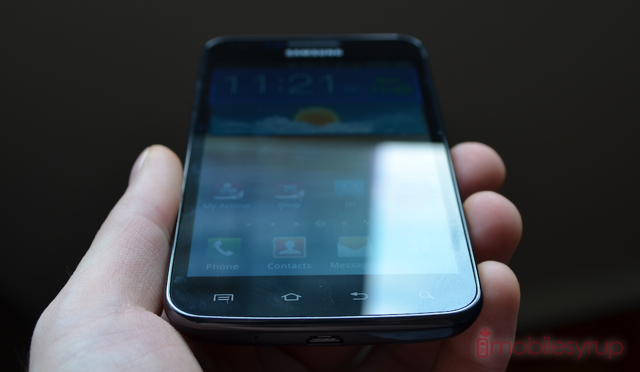
The Galaxy S II LTE runs Android 2.3.5 with TouchWIZ4. We’ve extensively discussed the OS in a previous review, so we won’t touch on that here. Suffice it to say, it’s smooth, fast and unobtrusive.
The device comes preloaded with the Swype keyboard which we’d recommend switching to immediately over Samsung’s underwhelming stock keyboard. The GPS found our location quickly and maintained a lock as we drove around the city looking for something to eat. WiFi and Bluetooth were stable and quick, and the latter sounded great when listening to music over our Nokia A2DP headset.
Rogers pre-loads several apps on the LTE including its UrMusic MP3 subscription service and store. While we wouldn’t recommend using it over dedicated stores such as 7Digital, or superior subscription services like Rdio or Slacker, it provides a decent and robust experience. The company loads a “New Releases” widget on one of the seven home screens, and prices are between 99c and $1.29 per track, though there is a sneaky and unconscionable 25c “transport fee” per song that bungles the experience completely.
Call quality was fantastic over Rogers’ network, with excellent clarity from the earpiece and substantial volume from the mono speaker on the back. We were very impressed with the noise cancellation on calls as we walked down the street on a blustery day, and when we got inside blasted a song from YouTube to satisfying levels without distorting.
We must mention that, like the Telus version this Galaxy S II comes with NFC capabilities built into the battery cover. Though its usage is rather limited at the moment, once the device gets upgraded to Ice Cream Sandwich it will benefit from the Android Beam feature that we looked at in our Galaxy Nexus review.
Conclusions
A couple months ago this would have been a contender for the best phone on the market. Now, with the impending launch of the Galaxy Nexus and several devices with 720p screens on the horizon, this device has only one saving grace: LTE. But as much as we talk about pixel density and processor speed what struck us when using this device was how much faster it felt than every other device on the market. We said the same about the HTC Raider: LTE is a game-changer. Considering we rely on a constantly-on internet connection for pretty well every aspect of our smartphone lives, it isn’t surprising that faster page loads, blazing file downloads and low ping times made us significantly happier than any benchmark result.
While we would have loved to see the screen of the Galaxy Nexus on here or the fantastic battery life of the Xperia ray, when you buy a powerful, modern device you expect to make some sacrifices. The screen is still beautiful, the processor still lightning quick. Add to that a dash of LTE, tremendous build quality and an excellent camera sensor, we can’t help but fall in love all over again.
That being said, the device is still launching with Android 2.3.5, a user experience we’d rather move past sooner than later. While the development community has been falling over itself bringing Ice Cream Sandwich to the original Galaxy S II, the official word is that Samsung’s entire fleet will be getting the upgrade in Q1 2012. Whether that means a month or three months remains to be seen; it also depends on the carrier pushing out the update soon thereafter. Canadian carriers and manufacturers have a mixed track record with updates — the original Bell Galaxy S received Gingerbread nearly eight months after it was announced — but they seem to be improving. Rogers, to its credit, has done a good job with its other devices: the Captivate was upgraded to Gingerbread quite late, while the Sony Ericsson Xperia series has been receiving steady updates as they come.
Until then this is about the best Gingerbread phone you can buy in Canada right now. Whether that makes you cringe or swoon is an indication of how much you like Android in its current form.
The Rogers Samsung Galaxy S II LTE is available for $179.99 on a 3-year term and $649.99 outright at Rogers, or $129.99 at Best Buy and Future Shop.
Rating: 7.5/10
Pros:
– Blazing fast network speeds
– Beautiful Super AMOLED Plus
– Good build quality, very business professional look
– Great camera and video quality
– Decent battery life for an LTE device
– Excellent overall performance
– NFC helps future-proof
– Loud and clear from earpiece and speaker
Cons:
– Screen resolution very low in comparison to some more recent devices
– Battery life still disappointing considering its size
– No expected date for Android 4.0 update
– So-so low light camera performance
MobileSyrup may earn a commission from purchases made via our links, which helps fund the journalism we provide free on our website. These links do not influence our editorial content. Support us here.

